Vinita Damodaran, Anindita Saha, Shibaji Bose (funded by the IDS Tapestry project)
This innovative school project facilitated by the University of Sussex that documents the narratives of children in a marginal environment has got off to a great start. The Sundarbans, the world’s largest contiguous mangrove forest, bordering the Bay of Bengal is situated in the Ganges delta and is an environment subject to frequent cyclones and rising sea levels. |Most recently, a cyclone of dramatic proportions, Amphan affected the region in May 2020. The home of the saltwater tiger, the region has 54 islands with an enormous biodiversity that were gradually intensively settled in the nineteenth century under the British. For the island-hopping communities, mainly lower caste, tribal and Muslim living here, the struggle for existence not only in terms of recovery and resilience in the face of natural disasters, but also their daily difficulties have had an effect particularly on children and youth magnifying their anxieties about their future. This unique School Project documents the voices of school children of this region with the objective of understanding and learning from their ‘uncertain’ worlds. The project has collected uncrafted narratives-oral, visual, photographic and written from 50 school children aged between 12-15 years in an initial pilot project from the Raidighi Shriphaltala Chandra Kanta High School in the Diamond Harbour subdivision of South 24 Parganas. The aims of the project are;
1. To listen to the voices of youth and children experiencing uncertainty and climate change in the Sundarbans towards reimagining their future.
2. To bring children’s voices in conversation with expert voices to co-produce and re-shape knowledge and to reframe debates on marginality, uncertainty and climate change. The target group for the project were Middle school children whose age ranges between 12 to 16 years and the methodologies adopted for accumulating these were to facilitate uncrafted narratives
Despite the ongoing COVID-19 situation and the restriction of movement the pilot project has produced some excellent results a selection of which is reproduced below. As we can see the students were mapping their world at a time when both the Cyclone and COVID-19 which left them facing a very uncertain future.
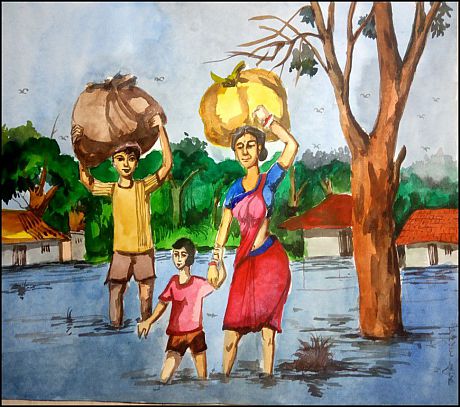
Remembering the Trauma
This image is painted by a 16-year-old girl Molli Naiya, a 10th standard student. Her father, Baburam Naiya, a State Government employee belongs to a lower caste group. She aims to be a government employee like her father in future. According to Molli’s visual narrative, her house was damaged and their entire locality was under flood water at the time of Amphan. She along with her parents and brother had to leave their home and search for a rescue centre immediately after the super cyclonic storm.
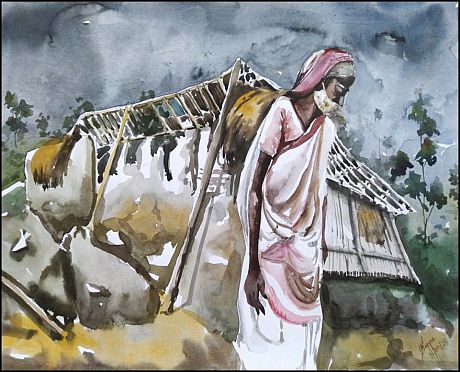
Cyclone Amphan cripples our Sundarbans
Bappaditya Mondal, a 16-year-old boy shares his experiences through this visual narrative. He is a 10th standard student. His father, Bijay Kumar Mondal is a farmer and his family who belongs to a lower caste community. He wants to follow his father’s profession in future. According to Bappaditya’s written narrative, cyclone Amphan has proved to be fatal for the people in Sundarbans under the current pandemic situation. His own mud house was swept away because of the effect of the devastative cyclone. The old lady seen in Bappaditya’s painting is his grandmother. She is wearing a mask that signifies dual uncertainty- Amphan and COVID
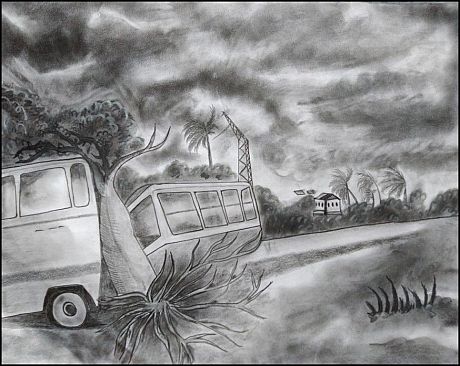
Witnessing death first hand
This is a vivid image from a child Chandan Biswas, a 10th standard student who witnessed the onslaught of Amphan. His father, Shri Narayan Biswas is a lower caste worker. Chandan wants to seek a government job in future. He writes that many trees were uprooted when the cyclone hit the Ganges delta. He witnessed one robust uprooted tree falling on a public vehicle killing two people during the agony of Amphan a traumatic experience that he records will forever be etched in his memory.
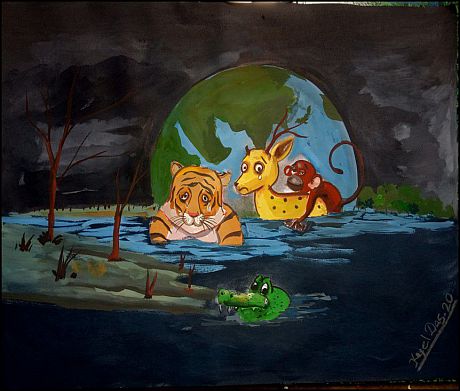
Our earth today has become an unsafe and dangerous place
Koyel Das, 15 years, a 10th standard student has painted this image. Her father Bikash Das is an Insurance Company’s agent and she belongs to a general caste. She wants to be a renowned painter in future. According to her written narrative, not only the people but also the entire bio diversity of the Sundarbans is severely affected by the recurring tropical cyclonic storms every year. Trees are turning yellow and red in this region after the devastating cyclone Amphan. Her visual narrative reflects the human and non-human aspect of nature and is a reminder that climate shocks like Amphan causes largescale destruction all around - human, flora, fauna. She said- “we have tried to tame the nature through our unsafe environmental activities and we are now paying the price.”
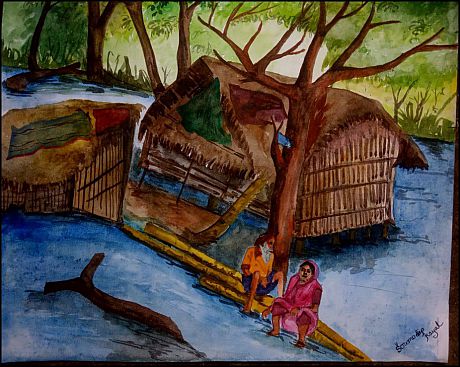
Homeless and struggling to find land and shelter
A 15-year-old child, Soumodip Koyal from the 9th standard has painted this visual narrative. His father, Shri Panchu Gopal Koyal passed away and his family belongs to a lower caste that was affected by the recent cyclonic storm Amphan. He writes in his written narrative that people were taking shelter on the tree trunk as the whole area emerged under flood water and mud houses were ruined because of the impact of devastating storm. The misery of the Sundarbans people is very clearly reflected in his visual narrative where people were using bamboo rafts for moving from their homes to a safe shelter.
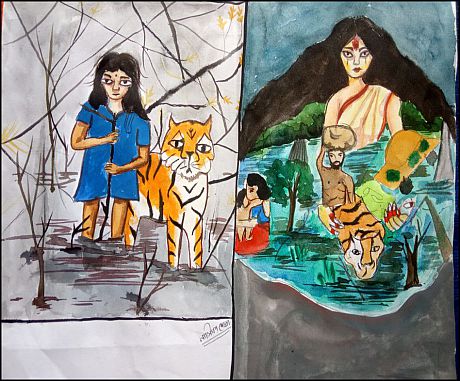
The two faces of mother
Nafisa Molla, 14 years, 8th standard child has shared this visual narrative. Her father is a Muslim labourer. Nafisa wants to be a school teacher in future and according to her observation there is still hope. Nature can be a destroyer but it can also be a care giver. It will depend on how we treat our planet. We can tweak the narrative here...
LEFT PICTURE: This is what happens if we don’t take care of Mother earth. It will render both the human and tiger without their habitation. We should look to a future which is beneficial to the humans and the creatures of the forest.
RIGHT PICTURE: Mother earth does not want to see her creations suffer.... she is seen here to be providing refuge to the human and the animals. But we have to take care of our Mother in the future.
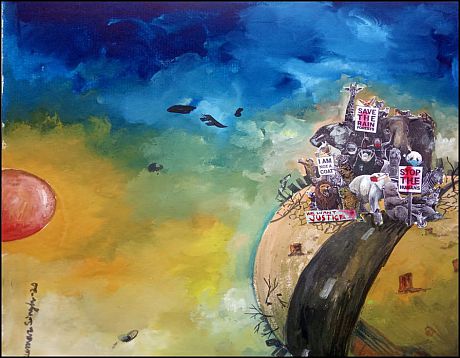
Climate change and a plea
Deb Kumar Singh, a student of 11th standard paints this visual narrative. His father has been trained in making ayurvedic medicines by his grandmother and he prepares medicines and sells them locally. They belong to a general caste. Deb Kumar wishes to establish himself as an artist and his visual narrative depicts how vulnerable humans and the animals are pleading with the world’s leaders and rich people to save the earth through environmentally safer practices
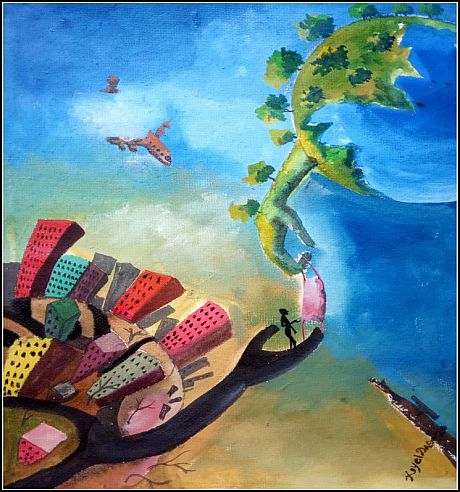
Concretising the planet
This is another painting of Koyel Das. According to her written narrative, she tries to depict the effect of urbanization on our green earth. She feels that such urbanization is one of the important factors of climate change. Concrete structures covering the whole earth gradually is feeling suffocating and asking for fresh air from the green earth. The green earth is extending her hand to help the urban forest. But she places a condition before the urban earth. She will hold the hand of the urban forest if she will reduce her pollution levels. Here the image of mask is very significant under the current pandemic situation.
It is clear from the narratives that we have collected from these students that they are quite anxious about their future. Most of them belong to a marginalised group or minority communities and have expressed only a limited interest in continuing to follow the precarious livelihood patterns of their parents who are mainly artisans and fishers or hold down insecure jobs. Many of the parents themselves are searching for alternative livelihoods as they are economically very poor and the prolonged lockdown under current COVID-19 conditions has increased their difficulties. Along with the tropic cyclonic storm “Amphan” COVID-19 has proved to be a doubled edged sword.
How can we work with this community of students and help them reimagine their future?
As Webb and Kirby note, ‘What is striking to us is how through their art and written narratives the young people (we think it’s important to refer to them as ‘artists’ to accord them the dignity and respect that their work warrants) have captured both their deeply embodied and emotional experiences of uncertainty, but equally a nuanced engagement with the complexity of how such uncertainty is lived with:
- Bodies weighed down by being uprooted, and the familial bonds (Bappaditya Mondal; Molli Naiya) and welfare services (Molli Naiya) that make such transitions possible.
- Nature that is at once menacing (the face in the clouds in Bappaditya Mondal’s image captures this) and offers hope through mother nature (Nafisa Molla; Koyel Das).
- Foregrounding of a relational animal/human connection in which humans have destroyed animal habitats and still the future of both are bound up together (Nafisa Molla; Deb Kumar Singh)’.
These are images result in what Webb and Kirby have called ‘uncertain’ pedagogies[1] that invite audiences (whoever they might be e.g. policy makers, scientists, planners) to respond in two overarching ways to the images/text, that demand them to situate themselves in relation to the art and the artists, and what is being conveyed.
- What is this to me? What does it mean to me? How do I read this beyond climate change as a scientific fact? What am I learning from this ‘artist’ that I didn’t know before, and that it wouldn’t be possible to know if not presented visually?
- What am I to this? Where am I in this story? What does this demand of me as human being? Consumer? Professional? Citizen?
These images will be part of a wider exhibition that we plan as a joint event in the Sundarbans, in Kolkata and Sussex in 2021.

